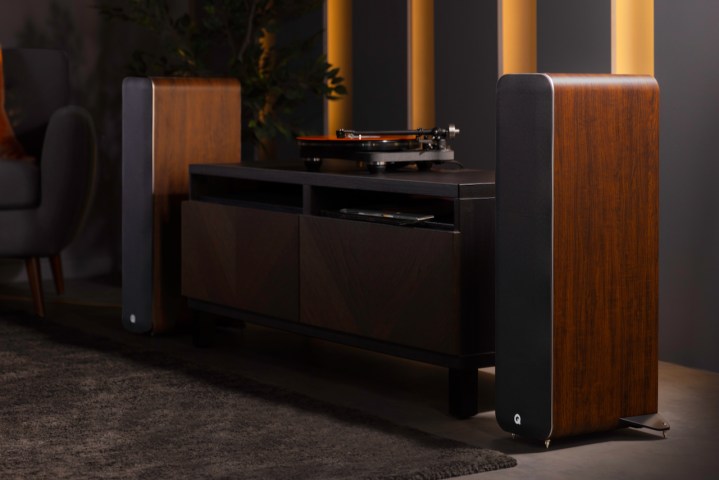
With its sights set squarely on the all-in-one powered speaker market, British speaker maker Q Acoustics today launched its new M40 powered “micro tower” speakers, a $999 wireless audio system with all kinds of connectivity that sits in the Goldilocks zone between big-power towers and more modest bookshelf speakers.
A taller and bigger version of its excellent M20 HD wireless bookshelf system, the Q Acoustics M40s aren’t quite as looming as many floorstanding speakers at just under 28-inches tall by 10-inches wide and 11.7-inches deep (its own 5050 floorstanders stand at 40 inches). But because they’re self-powered and feature a wide range of inputs and connectivity, including RCA line-in, 3.5mm AUX, optical, USB, and Bluetooth, they eliminate the need for big components like receivers and amplifiers.
With 100 watts of peak power (2 x 50 watts RMS) via Class D amplification, the M40s are no slouch in the volume department, to be sure, but as with the M20 HDs, it’s all that connectivity that makes these speakers a versatile option for any music room.
Analog sources like turntables (with built-in preamp or external phono stage), CD players, game consoles, or smartphones can be connected through the RCA and AUX inputs. TVs and network music streamers can connect to the TOSLINK optical, and computers and other compatible devices can use the M40s’ USB B port (the latter two connections can deliver up to 24-bit/192kHz resolution for streaming hi-res music from services such as Tidal, Qobuz, and Apple Music).
And as with the M20s, the M40s also supports up to 24-bit/48kHz from a compatible device via Bluetooth 5.0 with aptX HD and aptX Low Latency compatibility. Sadly, though, there is still so HDMI support.
The same C3 Continuous Curved Cone design of Q Acoustics’ 5000 series bookshelf (5010/5020) and floorstanding (5040/5050) passive speakers are present in the M40s as well, creating what the company calls the “best of both worlds” by combining “the outstanding bass performance of a traditional straight cone with the high/midrange control and fidelity of a flared cone” in its dual 5-inch mid/bass drivers. The M40s also feature a 0.9-inch decoupled top-mounted tweeter.

If the M20s are any indication, the cabinets of the M40s will be rock-solid in their build (the amplifier speaker weighs in at 27 pounds while the passive is slightly less at 26 pounds).
Also like the M20s, placement of the speakers is made easy thanks to a toggle switch that lets you select and change which speaker is left and right, allowing you to place the powered speaker where your power is. There’s also an EQ switch that adjusts the speaker’s sound depending on where it’s placed — in a corner, against a wall, or out in the open.
The Q Acoustics M40 speakers are available now at the Q Acoustics website and independent dealers and retailers for $999.







